Sat 28 Jun 2008
Archived Review: RICHARD ELLINGTON – It’s a Crime.
Posted by Steve under Authors , Characters , Covers , Crime Fiction IV , Reviews[18] Comments
RICHARD ELLINGTON – It’s a Crime. Pocket 756; 1st printing, Dec 1950. Hardcover: William Morrow, 1948.
Richard Ellington (1914-1980) wrote only five mysteries, and all five featured a Manhattan-based private eye named Steve Drake. This is the second of them, and for the record, using Al Hubin’s Revised Crime Fiction IV as a basis, here’s a list of all five, along with (eventually) paperback covers for all of them:
Shoot the Works. Morrow, 1948; Pocket #624, 1949.
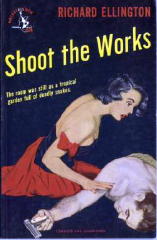
It’s a Crime. Morrow, 1948; Pocket #756, 1950.
Stone Cold Dead. Morrow, 1950; Pocket #813, 1951.
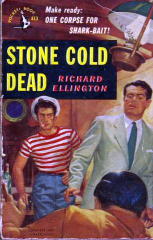
Exit for a Dame. Morrow, 1951; Pocket #941, 1953.
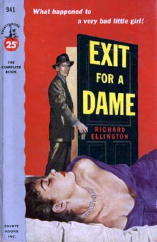
Just Killing Time. Morrow, 1953; Bantam #1286 as Shakedown, 1955.
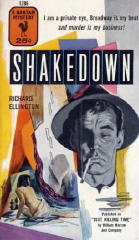
Thanks to the Cook-Miller index to digest mystery magazines, we learn that Ellington also published three short stories in Manhunt and one in Mike Shayne Mystery Magazine:
“Fan Club” Manhunt, April 1953.
“The Ripper” Manhunt, August 1953 .
“Shadow Boxer” Manhunt, February 1954.
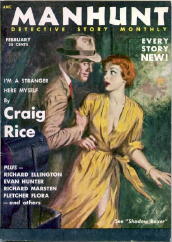
“‘Good-By, Cora'” Mike Shayne, February 1968
At least the first of these is a Steve Drake yarn as well. I’m not sure about any of the others. According to the brief biography of Ellington inside the front cover of this paperback edition, he was heavily involved with radio both before and after the war: acting, announcing and writing. What he ended up doing after the career in writing mysteries ended I don’t yet know; perhaps writing for television? (A later search on www.imdb.com turned up nothing.)
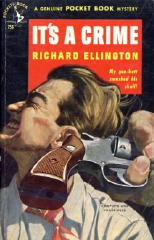
The cover of the paperback edition of It’s a Crime will give you an idea of the kind of mystery it is, or if not, at least it’s a portrayal of the one scene that the people at Pocket thought might sell the book. Paul Kresse is the artist, and in the center foreground is the butt end of a gun being grasped by the barrel (only part of the fingers showing) and being used to clout a man in the head. Side view, tie askew, he’s obviously in excruciating pain.
Quoted from the text: “My gun-butt smashed his skull.”
Granted that the scene is in the book, and so is another in close proximity of the same guy with a tommy gun, firing away at Drake before he gets away, only to turn the tables, as shown on the cover, but …
Steve Drake is really only medium-boiled, about 6 or 7 on a standard HB (hard-boiled) scale ranging from 1 to 10. I’ll quote Mr. Drake, who tells his own story, from pages 60-61:
Drake actually has two cases in this adventure. The first is a wandering husband caper. The second is a case of blackmail, the victim being the male half of a famous Broadway husband-and-wife duo. That the two cases are connected comes as no surprise to anyone who has read as many mysteries as you and I, but Drake himself takes it in with a slightly perplexed stride.
What is surprising, and it really shouldn’t have been, is that this prime example of lower-echelon tough-guy fiction turns out to have a complex and finely tuned detective story plot to go with it. There are many, many people with access to the dead girl’s apartment, and before her death there were enough of them going in and out that it would take a minute-by-minute timetable to keep it all clear.
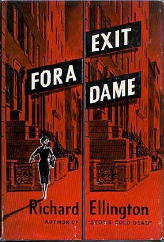
After the non-essentials have been eliminated, all of the suspects that remain have iron-clad alibis, and takes a huge effort in deduction on Steve Drake’s art to crack one of them. It’s a plot worthy of Ellery Queen, say, without quite the same finesse — relying on what seems like sheer chance on the part of the killer, and of course the aforementioned coincidence that involves Drake in both cases to begin with.
It’s a neat double combo, in other words, and very much worth seeking out. I’d especially like to locate my copy of the next book in the series. The love affair that Drake seems to find himself in as this one goes along seems to bloom very quickly, and if I read the last couple of pages correctly, Drake proposes marriage and the same time he says he going to be spending the money he made on this case on a trip to St. Thomas. Does she go too, or will she wait for him patiently at home?
These are things an inquiring minds like to know.
[UPDATE] 06-28-08. Prompting my posting this review from the past was an email this morning from SF writer Robert Silverberg:
“What he did was open a hotel in the Caribbean — perhaps on St. Thomas. (I don’t remember which island, really — it was a long time ago.) I visited it somewhere in the early 1960s and spent a pleasant afternoon exchanging shop talk with him, he talking about mysteries and me about science fiction. As I say, a long time ago, and I have no other details to offer.”
Then from a follow-up email:
June 28th, 2008 at 6:51 pm
I was surprised to see he had so little published — he must have made the money for buying the hotel from other things, perhaps tv work. Not that the hotel was very grand; it was just a little bed-and-breakfast sort of thing, and prices were cheap in those days.
Bob
July 2nd, 2008 at 12:51 pm
[…] was pleased to see your posting on Richard Ellington. In addition to being one of my favorite P.I. writers of the late 40s and […]
January 18th, 2010 at 9:50 am
Richard “Duke” Ellington and his wife Kay, had, for many years a guesthouse business on the island of St. John in the U. S. Virgin Islands. It was called Gallows Point, named after the point of land that borders one side of the harbor of Cruz Bay.
I was raised on St. John and knew the Ellingtons. They ran the business from the early ’50s to sometime in the 1970s.
July 1st, 2010 at 1:20 pm
I work at the Gallows Point Resort and am looking for any information anyone may have about Duke Ellington. There used to be several cottages on property that Duke rented out. Since then the cottages have been torn down, around 1980 I believe, and the current buildings were built. I am piecing together the history and am finding out that Duke was quite the character.
October 4th, 2010 at 2:36 pm
My sister and her husband, now both deceased, stayed at Gallows Point in the late 60’s-early 70’s. I would love to know a bit of the history, too. Karla, what have you found out?
October 10th, 2010 at 10:15 pm
I would love to know more about Duke and Kay Ellington. He was my fathers uncle through marrige on my Grandmothers side. My Dad, also named Richard, lived with them for a time when he was in his early twenties. I have all of his books, however, they were in storage for so many years they really are no longer readible… Which is a shame. Would love to know more.
May 10th, 2011 at 4:35 pm
I worked for “Duke” Richard at Gallows Point when I was 16 (bartender) until I went in the Navy off and on (when I didn’t quit or get fired). My family and I lived in the Gate house at the point when we first moved to St Johns. in 59/60 there where 7 cottages and the main house
May 10th, 2011 at 4:44 pm
sorry to be back but I should have proof read my first entry I stayed in the navy but quit or got fired on/off. Duke wrote the old radio show “the Fat Man” and also wrote an early TV show I thinf was called the Detectives? not sure on the name.
May 17th, 2011 at 2:13 pm
My family used to live just down the road from Gallows Point in the early 1960’s and like many of the local adults, my parents frequented “Duke’s” bar. It must have been around ’63 or so that cowboy actor and star of the TV show “The Texan”, Rory Calhoun, along with a couple of Hollywood types were in St. John trying to work out film deal for Duke’s “Stone Cold Dead”. Unfortunately that’s as far as the project got.
May 19th, 2011 at 11:29 am
Backround on why Duke was at the ’64 GOP convention. Earlier in the year the local Unity Party merged, via a hostile take-over, with the Democrats, this left Islands with essentially only one party. Senator Moorehead (“Mooie”) convinced many of the local “continentals” to form a St. John GOP.
My parents were elected President & Secretary, the Rev. George Starling VP & Duke National Committe-man. Naturally the Party meetings were held at the Gallows Point Bar. And now that I think of it, Duke’s brother’s name was Steve so that be the inspiration for his etective character.
December 21st, 2012 at 6:30 pm
My parents (Ginny and Al Atkinson) knew Kay in College (Ohio Wesleyan). She was the sister of Bill Lamb (also OWU) who married my father’s sister Margery (also OWU). I’m not sure where Kay met Duke but they lived in NYC after WW11 (Duke was in the battle of the Bulge, in the army). He was an actor on radio and was the lead in “The Fat Man” for a time in NYC. At the time we lived on Long Island and would go into the city for dinner with them. On a cruise of the Caribbean, they saw some land on a small peninsula in Cruz Bay, St. John and bought it. They eventually built the main house for themselves and another one (cement block) for rent plus the bar at the top of the hill with a magnificent view. Then 3 or 4 more cabins were built of wood further down the hill toward the water. They all had kitchenetts.
Duke would sit up at the bar and hold forth with stories and histrionics. He would also do some writing there. At some point he had a detective show on the radio that was recorded on St. Thomas once a week. My father was even one of his actors during a vacation. My parents managed to go there about once a year for all the time that the Ellington’s owned the place. My brother and I each had our honeymoons there in the 60’s. Kay and Duke were our godparents.
When bad health arose, they spent their final years in a condo in south Florida.
December 21st, 2012 at 6:33 pm
p.s. Duke grew up in West Virginia
May 24th, 2013 at 12:42 pm
How wonderful it was to read the reminiscences of Duke and Kay. My late first husband Phil and I first went to Gallows Point in 1963, when I was 6 months pregnant. It was the beginning of many winter vacations spent there. Cruz Bay was mostly unpaved in those days and we walked every where. Church was held in an outdoor gift shop and restaurant, the priest arriving from St. Thomas with his vestments etc. in a suitcase. Peacocks and donkeys freely roamed the streets. Life was simple and we loved it! Those evening at Duke’s bar were fabulous. We would bring up hors d’oeurves and share them. I even collected snails from the rocks and served them in garlic butter. Life got difficult after Kay was badly injured in an accident and recovery was not great. It was a wonderful era.
June 19th, 2013 at 2:11 pm
My cousin has just sent me a packet which included several carefully preserved mysteries written by “Duke” Ellington. I visited Gallows Point, perhaps in 1965, when staying with my aunt and uncle in their small cottage in Cruz Bay. I went to an unforgettable, extremely strange, production of the Japanese play Rashomon one evening at Gallows Point. Duke was charming and hospitable to this young college student, and my cousin wanted to give me something to remember those happy days.
June 5th, 2018 at 8:31 am
Enjoyed reading everyone’s posts and memories of Gallows Point and Duke Ellington. Our family vacationed there in the late 1960s. Our favorite cottage was the “yellow’ cottage. Would love to write a blog post about Duke and Gallows Pt. Does anyone have any photographs of him they can share? Thanks again. VintageVirginIslands.com
June 25th, 2018 at 9:11 am
1.We enjoyed Duke’s round bar. Ah, memories.
2. I think the radio show might have been….”THE THIN MAN” We were impressed when he spoke of it.
3. Duke had a way of selling Gallows Point to visitors…often… I don’t remember the details but he got deposits and then months later he rescinded the sale and gave the money back to the mark. Nice way to get interest-free capital for >>>?
January 23rd, 2020 at 6:40 am
Hi, I would like to hear more stories about Kay & Dick. I am also a family member to both. Send me an email to lambphoto@hotmail.com.
Dave Lamb
September 8th, 2021 at 8:24 pm
My wife and I spent several 2-3 week vacations at Gallows Point from 1969-1971. Anyone interested in several color photos of Kay and Richard, with or w/o us sitting at the ‘al fresco’ bar, pl let me know. Give your address, use my email address to pay two bucks via PayPal and I mail off copies.
Helmut Schwarzer
17 Morse Lane
Newbury, NH 03255